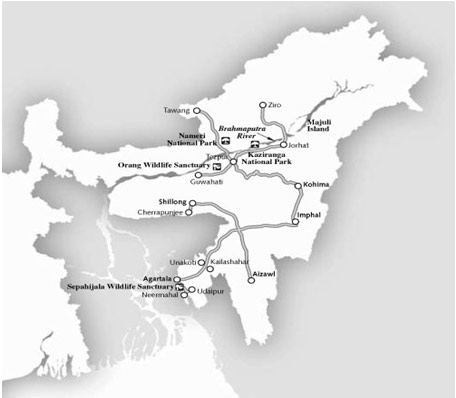Is India’s Transport Infrastructure Prepared for the Eastern Front?
China’s rapid build-up of infrastructure along the Line of Actual Control (LAC) is compelling Indian policymakers to rethink border issues and in particular focus on increasing military capability by strengthening infrastructure in the border areas. But, infrastructure development remains uneven in the northern and eastern sectors. While the creation of military infrastructure including transportation has picked up in the northern sector, there is a considerable lag of infrastructure development in the eastern sector. This has undermined India’s military capability to thwart external aggression in the eastern front.
China has connected all the passes and military posts on the LAC with highways, logistic depots and military installations – a clear sign that the People’s Liberation Army (PLA) is gearing up for military contingencies. The major highways on the Chinese side have been upgraded to double lane; they are also all-weather roads and thus operational throughout the year. With a total road network of 58,000 kms as of 2010 in the Tibet Autonomous Region (TAR), the Chinese are in the process of extending the Qinghai Tibet Railway up to Xigaze. Further, another railway line from Kashgar to Hotan in the Xinjinag Uighur Autonomous Region (XUAR) is under construction as also five airfields in Tibet at Gongar, Linchi, Pangta, Hoping and Gar Gunsa.1
In response, India has increased its military deployments in the eastern sector. The Indian air force has deployed four squadrons of frontline Su-30 MKI fighters in Tezpur and Chabua. The Indian army has raised two new mountain divisions with HQs in Zakama (56 Division) in Nagaland and Missamari (71 Division) in Assam, and is also considering the deployment of Ultra Light Howitzers and light tanks. Several new and old airfields have been activated and new roads are being constructed to enable the quicker movement of troops and equipment.2 But these initiatives pale in comparison to the military forces that China can mobilise along the LAC. With its five fully operational airbases and extensive rail and road network, China can mobilise more than 30 divisions (each with over 15,000 soldiers) along the LAC and outnumber the Indian forces by 3:1.3

Source: DoNER, Government of India, NER Databank
In contrast, India’s transportation infrastructure in the Northeast is inadequate, and what exists is outdated. Motorable roads do not exist beyond the state capitals and some townships. As part of the 10th Five Year Plan (2002-2007), the central government had sanctioned Rs 1690.26 crore for building 36 roads of a total length of 1905.60 km.4 But, even today, these roads remain in various stages of construction throughout the region. Moreover, the Northeast is a high rainfall zone, receiving an average of 2000 millimetres a year. As a result, landslides are common, thus requiring repair and maintenance of roads annually. However, repair and upgradation of roads in the region are seldom done, which means they lie broken and potholed.
Air connectivity in the Northeast is also much below the national average. Only Guwahati and Agartala airports have night landing facilities. In the ninth Five Year Plan (1997-2001),5 provision was made for six airports in Arunachal Pradesh, namely Itanagar, Pashighat, Zero, Tezu, Along, Daporizo, as well as for another at Rupsi in Assam. They were to be capable of receiving Airbus and heavy cargo aircraft. But because of uneven terrain and lack of space to build long runways, these airports have still not become functional.
The railways, being economical and capable of transporting large loads, could potentially integrate far flung areas, cut down the cost of goods in the border towns and promote development. But, the Northeast Frontier Railway that passes through Dimapur (Nagaland) and terminates at Dibrugarh (Assam) is the only rail link between the Northeast and the rest of India. Till recently, the rail network (mainly broad gauge) was limited to Assam though it has now been extended to Agartala (Tripura). Its further extension to the rest of the Northeast region remains uncertain.
As for bridges, during the 5th and 6th plan periods (1974-1979 and 1980-1985), most bridges constructed were made of timber. Later, in the ninth Five Year Plan, the central government initiated the conversion of existing timber bridges into reinforced concrete (RCC) bridges. Since 2001-2002, the conversion of 40 such bridges has been completed, while another 77 bridges are in the process of being thus converted.6 However, most of the RCC bridges constructed so far have already been worn out by heavy rain and also because inferior quality construction material was used. Consequently, most remote border areas remain connected only by timber, bamboo and cane bridges, except for the few on the national highways.
Despite the recent acceleration of efforts to build up infrastructure along the LAC including 5,500 permanent defences and bunkers, much more remains to be done. The rear areas and the forward positions are yet to be connected through proper motorable transportation networks. As a result, the military infrastructure development projects costing Rs. 9,243 crore, as approved by the Cabinet Committee on Security for the Eastern Army Command, are unlikely to be able to help India counter China’s build up. It is imperative that the transport connectivity in the region be strengthened by the establishment of railway networks in the hinterland, by the timely construction of roads that extend to the borders, and by expediting the construction of bridges.
- 1. “China building defence installations near LAC”, The Asian Age, March 25, 2011, available at http://www.asianage.com/india/china-building-defence-installations-near-….
- 2. “China has 58,000 kms of road network in TAR: Antony”, The Hindu, March 7, 2011.
- 3. “India strengthens up China Front to Counter The Dragon”, June 06, 2011 available at http://www.defencenews.in/defence-news-internal.asp?get=old&id=517
- 4. Report on roads, North-East Council, Government of India, 2008, available at http://necouncil.nic.in/index3.asp?sslid=137&subsublinkid=452.
- 5. Ninth Five Year Plan, Planning Commission, Government of India, available at http://planningcommission.nic.in/plans/planrel/fiveyr/9th/vol2/v2a7-1.htm
- 6. Conversion of existing timber bridges to RCC permanent bridges on the NEC completed Road schemes, North-East Council, 2008, available at http://necouncil.nic.in/index3.asp?sslid=342&subsublinkid=456.




